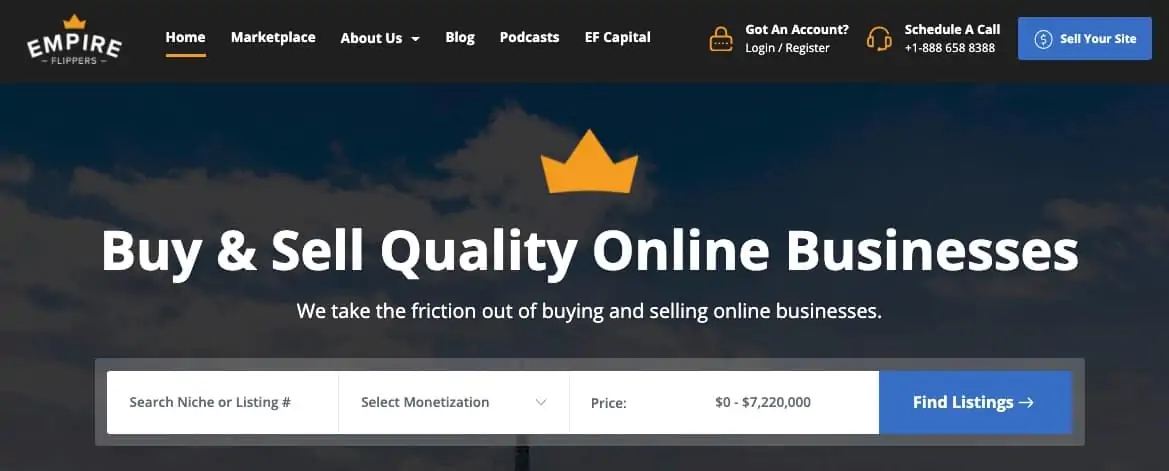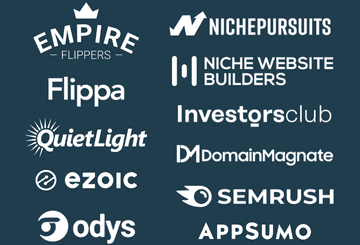Knowing that blogs are in high demand and knowing how to sell your blog for profit are two different things. Anytime you’re selling an asset like a blog you want to make sure you’re getting the best possible deal.
A lot of work went into building the blog and wanting to be paid a fair market price isn’t unreasonable.
The demand for profitable blogs is huge and is growing. Let’s jump into everything you need to know to sell your blog for a profit.
Why Decide To Sell a Blog: 3 Reasons
Selling a profitable blog might seem like a strange idea to someone who spent months or even years building their first one, but there are multiple reasons this could make sense.
1. Liquidity
Don’t overlook the power of liquidity. There’s a reason there are dozens of old sayings that basically break down to money on hand is better than money promised. A one-time payment for the sale puts a large amount of money into your bank account all at once.
While passive income is nice, getting 35x to 45x monthly revenue all at once can be life-changing, which is how blogs are typically valued. Having that level of money on hand also opens up options for the seller.
It’s one thing to have faith that a blog making $2,000 a month will continue without any issues for years, it’s another matter entirely to have $60,000 to $80,000 in a bank account right now.
2. No Longer Interested in the Blog Topic
Most niches have serious competition. If you’re interested in a blog topic, it’s much easier to be excited and tackle the amount of work that needs to be done to be competitive.
If that interest wanes, then doing the work will take longer, be more stressful, and it probably won’t be as good as the work that was done when you were excited.
Instead of burning out, sell for the payout and move on to a more interesting topic.
3. Want to Focus Effort & Money into Another Business
Selling a profitable blog, especially with the proper website valuation, can be a great way to raise a large amount of money to pour into another business.
This could be one that is more interesting to you, more profitable, or ideally both.
This also allows you to take the work, effort, and focus the current blog takes up and move that to another business.
How Much Can You Sell a Blog for?
The current market rate for figuring out how much you can sell a blog for is the average monthly income of the last 6 months (12 if the site is seasonal), times 35 to 45. That 35 to 45 range is called the monthly multiple and will vary based on site age, backlink profile, attached social media accounts, and other similar factors.
Here is the formula:
This means a profitable site earning $1,000 a month could easily be sold for $35,000 to $45,000 assuming there were no odd red flags attached to the domain or site.
This is part of what makes selling a blog so appealing. The pay-off is fantastic.
What Makes A Blog More Valuable?
There can be a huge difference between a 35x multiplier and a 45x multiplier. The more a blog earns per month on average, the more money a small multiplier will cost you compared to a large one.
Some things are beyond a blog owner’s control, but the following five things are in the control of a blog owner and can lead to higher multiples during the sale.
1. Multiple Traffic Sources
While organic traffic from Google is widely seen as the most valuable, having traffic from multiple sources is a major selling point for a site. This includes other search engines, social media, direct traffic, traffic from links on guest posts or other mentions.
A site that pulls traffic from multiple sources is safer and is going to be able to encourage a higher multiplier.
2. Multiple Income Sources
Having income from just one display ad network or just one affiliate can work, but it’s also leaving money on the table. Having multiple income sources means not only does your monthly revenue go up, but this looks safer to potential buyers.
Look at multiple affiliates, video ads, display ads, online courses, or other digital products that could work with your niche.
Multiple income sources make a blog more valuable on the sale.
3. Digital Products
Recurring revenue from membership is very attractive to buyers. In addition, large courses with a strong reputation add to the value of the site. This is a product that can continue to be sold, used to keep bringing in new traffic, or even be the foundation for future products.
Not every niche will be appropriate for this, but there’s a huge income opportunity when done correctly.
4. Active Email List
A common saying in marketing is “The money’s in the list.” This refers to an email list, and sure enough, an email list from engaged readers and customers is incredibly valuable.
Those are people who not only believe in the brand but are much more likely to buy future courses or products.
5. Active Social Media Accounts
Active social media accounts with a strong following are going to be a major plus, especially if there is more than one attached to the site.
Keep in mind size and engagement matter. Just having social media accounts won’t matter much if each one only has 10 followers and is rarely updated.
Where to Sell a Blog
There are many different places to sell a profitable blog. When you want the attention of a large number of buyers with the budget to make a major purchase, finding a quality broker is extremely important.
Flippa
Flippa is the largest open marketplace for buying and selling websites. Many thousands of investors are on Flippa daily looking for good deals or blogs to add to their passive income portfolio.
Listing at Flippa will get a huge number of eyes on your for sale listing.
Empire Flippers

Empire Flippers brands itself as the largest vetted marketplace for buying and selling websites. This is one of the most popular brokers for buyers with a solid budget looking for sites that have already gone through at least one round of vetting.
Other Website Brokers
There are many good website brokers out there aside from these two. Some are beginner-friendly, some only specialize in 6-figure sales or more, but there are dozens of reliable options outside of Flippa and Empire Flippers.
10-Step Process of Selling a Blog
This process of selling a blog can seem a bit overwhelming for a first-timer, but it’s actually a very structured step-by-step process if you have a good plan.
The blog-selling process:
- Decide on selling and make a plan
- Position your blog for sale the 6-12 months before actually listing it
- Create a profit and loss statement
- Prepare all proper documents including traffic analytics and revenue numbers
- Remove yourself as the face of the brand
- Make sure all analytics for this site are separate from your others and create separate email accounts/Analytics tracking if necessary
- List your site for sale (likely at a website broker)
- Accept the offer from a buyer
- Use escrow
- Transfer the site once funds are in escrow
Follow this process and the process of selling your blog should go smoothly. Especially if working with a broker offering solid support.
5 Lessons From Someone Who Flipped 190+ Blogs
When you flip over 180 blogs, you learn all the details on how to have a successful flip. The following five lessons are the most important from my experience.
1. Treat a Blog Like a Business When Selling
You are selling an asset. This isn’t about a hobby or a passion, but taking a business asset, making it look as attractive as possible, and then selling for maximum value.
Viewing the blog as a business is important to spend time and energy on the details that move the needle versus aesthetics or details that simply don’t matter.
2. Keep Detailed Records
This goes for the building of the blog, everything spent on building and growing it, and every step of the sales process. The blog is a business, and the level of detail in the records should reflect that accordingly.
This is extremely useful when you need that information for a potential buyer, and it’s important if there’s ever a disagreement or potential issue in the future.
3. Remove Yourself as the “Face” of the Blog
When you’re looking to sell you want to remove your likeness from the blog. This lets the new owner brand as they see fit, but also do you really want your face or likeness appearing on a property you no longer control?
This is not only good for the new owner but it also protects you and your online likeness on future blogs/sites you may end up building.
4. Make it as Passive as it Can Be
Passive income is attractive to buyers. The less active work they have to do, the more likely you are to get bids at the higher end of valuation.
You also want to remove yourself as much as possible from the day-to-day running of the blog leading up to the sale so everything is systemized for the buyer.
5. It Can Take Some Time to Find the Right Buyer
The first offer isn’t always the right one. An unusually low first offer isn’t necessarily a sign you’re overpriced, either.
While it can be frustrating to have to wait weeks or even months at times, waiting for the right buyer is always worth it.
Takeaways – Should You Even Sell Your Blog?
While selling a blog can be tempting, especially when a big pay-off is involved, for some bloggers they might decide even a six-figure payout isn’t worth selling for.
So how do you know whether you should hold or sell?
You should consider keeping your blog if:
- If you love the blog topic
- Are excited to work on the blog each day
- Enjoy the freedom a passive income offers
- Don’t have any other active sites, blogs, or topics that grab your interest
If all of these apply, maybe it’s just not time to sell. If your mind ever changes on one or more of these, at least now you have this resource to walk you through selling your blog for the most possible profit!




